Exhibit 99.1

Alterity Therapeutics ( NASDA Q: A T HE, ASX : A T H) D avi d S ta m le r , M D CEO Ma r c h 2022
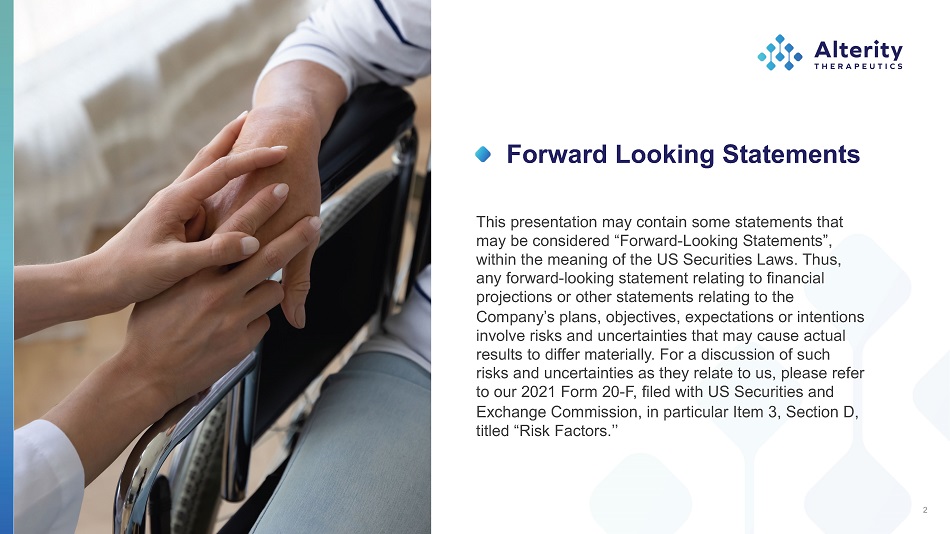
Forward Looking Statements This presentation may contain some statements that may be considered “Forward - Looking Statements”, within the meaning of the US Securities Laws. Thus, any forward - looking statement relating to financial projections or other statements relating to the Company’s plans, objectives, expectations or intentions involve risks and uncertainties that may cause actual results to differ materially. For a discussion of such risks and uncertainties as they relate to us, please refer to our 2021 Form 20 - F, filed with US Securities and Exchange Commission, in particular Item 3, Section D, titled “Risk Factors.’’ 2

Alterity is dedicated to creating an alternate future for people living with neurodegenerative diseases. Alterity means the state of being different Our goal is to modify the course of disease We’re here to disrupt the trajectory of illness and improve quality of life 3
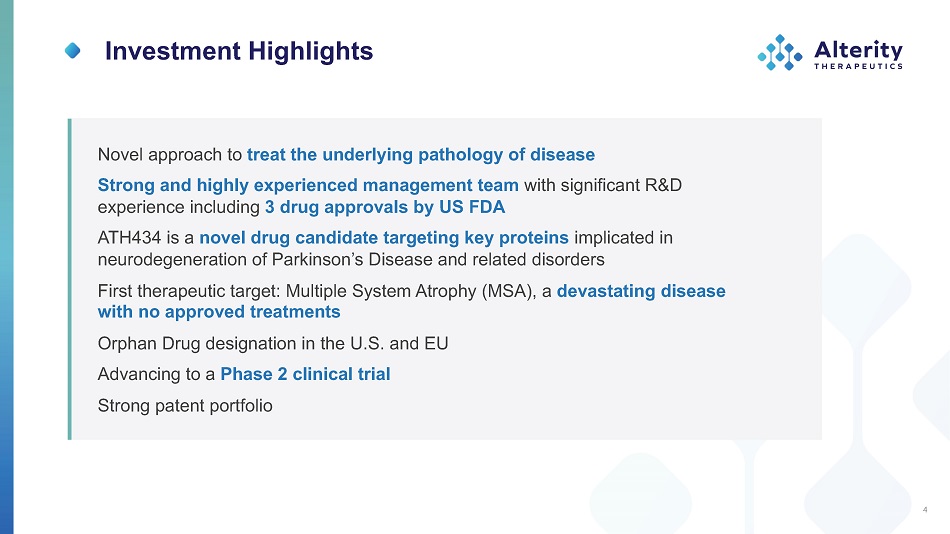
Investment Highlights Novel approach to treat the underlying pathology of disease Strong and highly experienced management team with significant R&D experience including 3 drug approvals by US FDA ATH434 is a novel drug candidate targeting key proteins implicated in neurodegeneration of Parkinson’s Disease and related disorders First therapeutic target: Multiple System Atrophy (MSA), a devastating disease with no approved treatments Orphan Drug designation in the U.S. and EU Advancing to a Phase 2 clinical trial Strong patent portfolio 4

Recent Progress Presentation of advanced quantitative MRI as potential novel biomarker in early MSA Two new US patents expand portfolio of next generation compounds for neurodegenerative diseases Publication demonstrating neuroprotective effect of ATH434 in animal model of MSA Michael J. Fox Foundation grant for ~US$500K for Parkinson’s disease EMA endorses clinical strategy for Phase 2 study in early MSA patients US FDA provides development path w a y fo r A T H 43 4 in Mu l t i p le System Atrophy Expanding bioMUSE Natural History study in early MSA 5
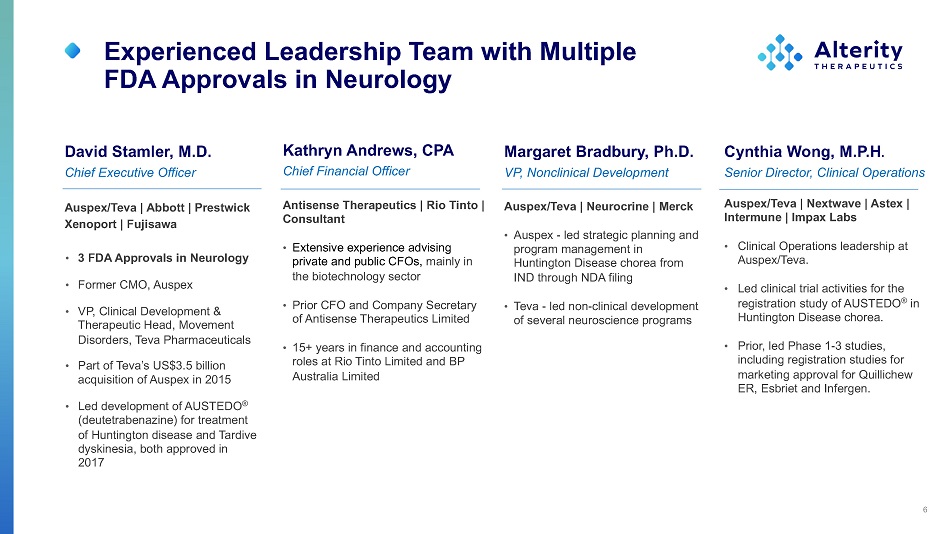
Experienced Leadership Team with Multiple FD A App r o vals in N e u r o l ogy Margaret Bradbury, Ph.D. VP, Nonclinical Development Auspex/Teva | Neurocrine | Merck • Auspex - led strategic planning and program management in Huntington Disease chorea from IND through NDA filing • Teva - led non - clinical development of several neuroscience programs Kathryn Andrews, CPA Chief Financial Officer Antisense Therapeutics | Rio Tinto | Consultant • Extensive experience advising private and public CFOs, mainly in the biotechnology sector • Prior CFO and Company Secretary of Antisense Therapeutics Limited • 15+ years in finance and accounting roles at Rio Tinto Limited and BP Australia Limited David Stamler, M.D. Chief Executive Officer Auspex/Teva | Abbott | Prestwick Xenoport | Fujisawa • 3 F D A A pp r o va ls in Ne u r ol og y • Former CMO, Auspex • VP, Clinical Development & Therapeutic Head, Movement Disorders, Teva Pharmaceuticals • Part of Teva’s US$3.5 billion acquisition of Auspex in 2015 • Led development of AUSTEDO ® (deutetrabenazine) for treatment of Huntington disease and Tardive dyskinesia, both approved in 2017 Cynthia Wong, M.P.H . Senior Director, Clinical Operations Auspex/Teva | Nextwave | Astex | Intermune | Impax Labs • Clinical Operations leadership at Auspex/Teva. • Led clinical trial activities for the registration study of AUSTEDO ® in Huntington Disease chorea. • Prior, led Phase 1 - 3 studies, including registration studies for marketing approval for Quillichew ER, Esbriet and Infergen. 6
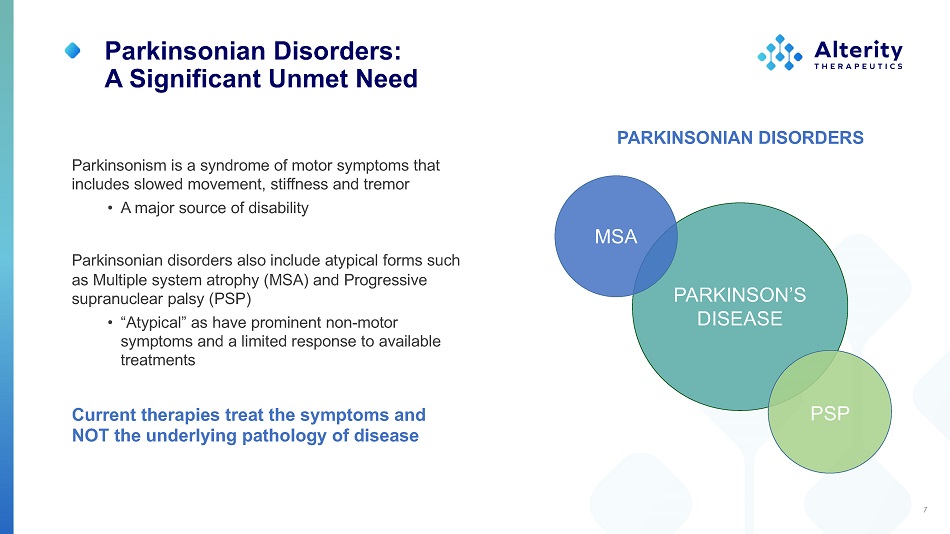
Parkinsonian Disorders: A Significant Unmet Need Parkinsonism is a syndrome of motor symptoms that includes slowed movement, stiffness and tremor • A major source of disability Parkinsonian disorders also include atypical forms such as Multiple system atrophy (MSA) and Progressive supranuclear palsy (PSP) • “Atypical” as have prominent non - motor symptoms and a limited response to available treatments Current therapies treat the symptoms and NOT the underlying pathology of disease P A R K I N S O N’ S DISEASE M SA PSP PARKINSONIAN DISORDERS 7
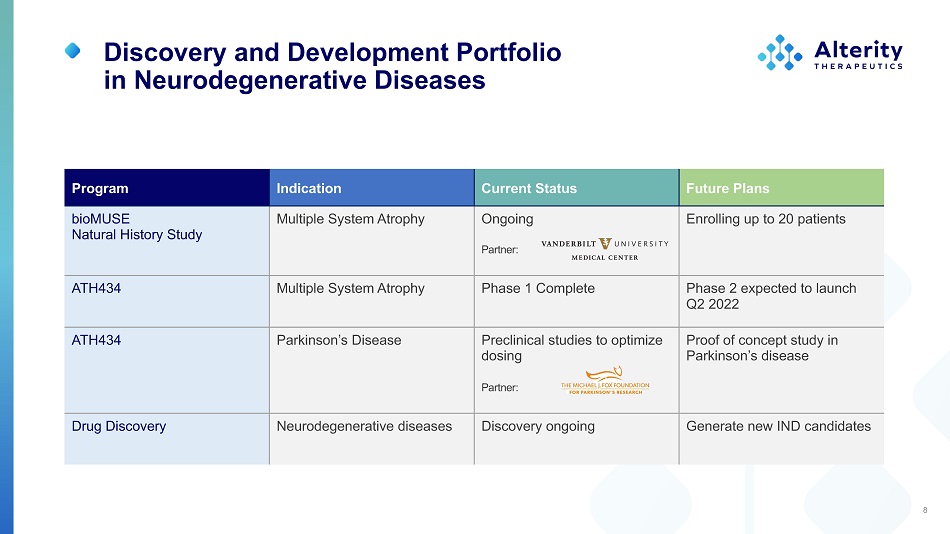
Discovery and Development Portfolio in Neurodegenerative Diseases Program Indication Current Status Future Plans bioMUSE Natural History Study Mu l t i p le Sys te m A troph y Ongoing Partner: Enrolling up to 20 patients ATH434 Mu l t i p le Sys te m A troph y Phase 1 Complete Phase 2 expected to launch Q2 2022 ATH434 Parkinson’s Disease Preclinical studies to optimize dosing Partner: Proof of concept study in Parkinson’s disease Drug Discovery Neurodegenerative diseases Discovery ongoing Generate new IND candidates 8
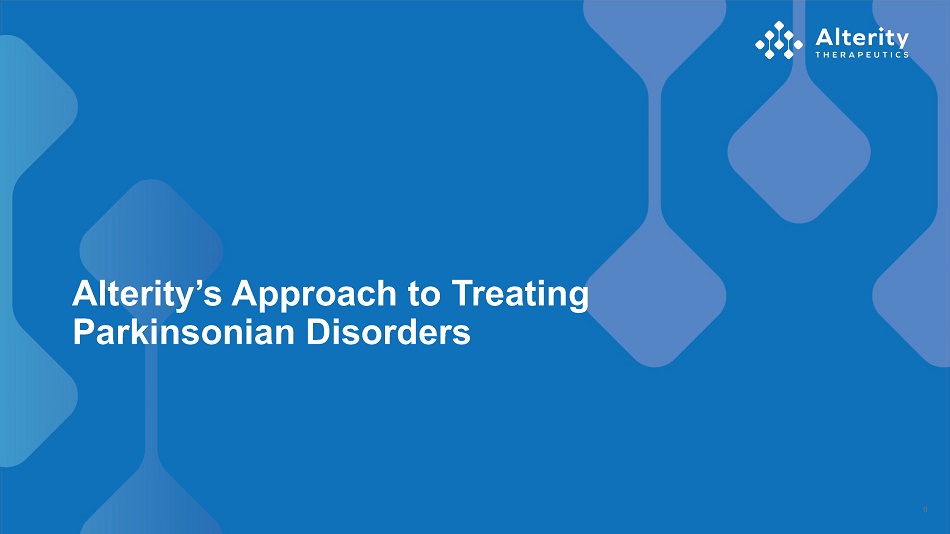
Alterity’s Approach to Treating Parkinsonian Disorders 9
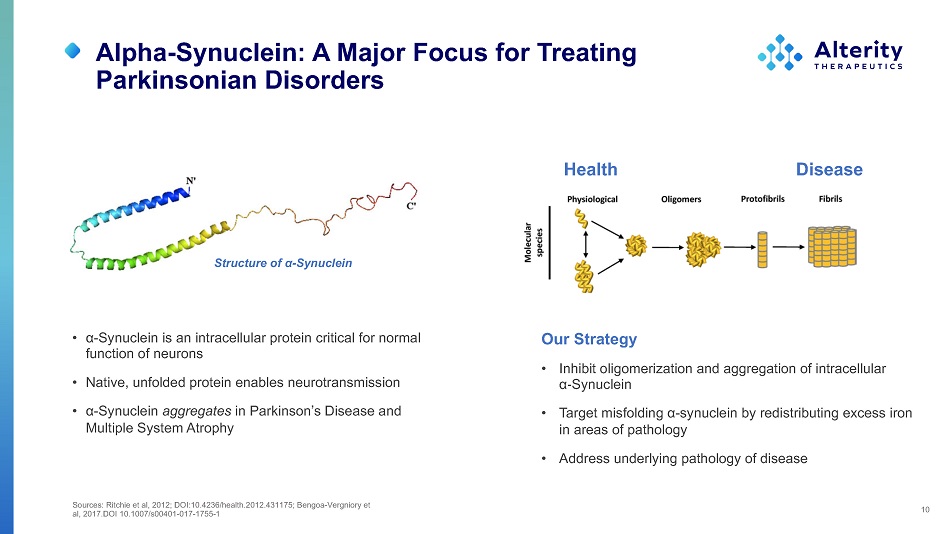
Alpha - Synuclein: A Major Focus for Treating Parkinsonian Disorders Sources: Ritchie et al, 2012; DOI:10.4236/health.2012.431175; Bengoa - Vergniory et al, 2017.DOI 10.1007/s00401 - 017 - 1755 - 1 10 • α - Synuclein is an intracellular protein critical for normal function of neurons • Native, unfolded protein enables neurotransmission • α - Synuclein aggregates in Parkinson’s Disease and Multiple System Atrophy H ea lth Di seas e Our Strategy • Inhibit oligomerization and aggregation of intracellular α - Synuclein • Target misfolding α - synuclein by redistributing excess iron in areas of pathology • Address underlying pathology of disease Structure of α - Synuclein
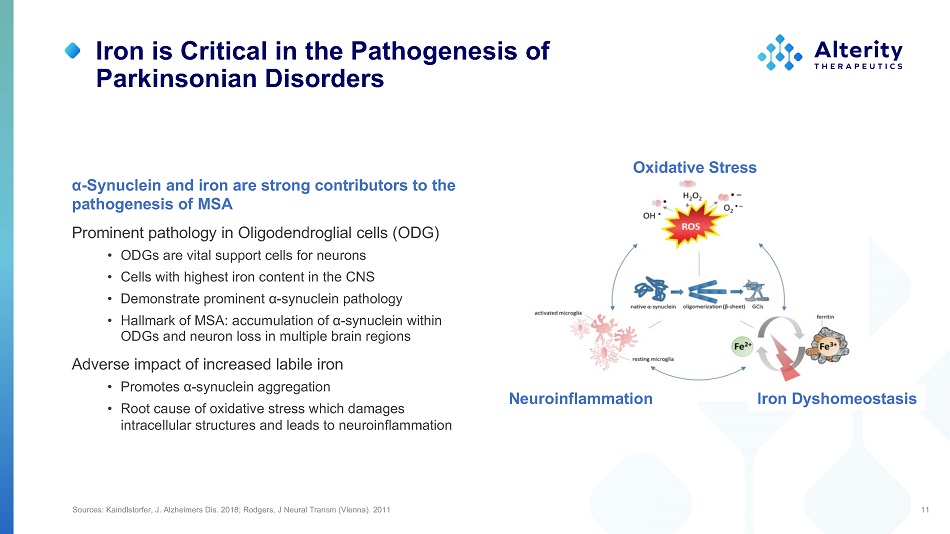
Sources: Kaindlstorfer, J. Alzheimers Dis. 2018; Rodgers, J Neural Transm (Vienna). 2011 11 α - Synuclein and iron are strong contributors to the pathogenesis of MSA Prominent pathology in Oligodendroglial cells (ODG) • ODGs are vital support cells for neurons • Cells with highest iron content in the CNS • Demonstrate prominent α - synuclein pathology • Hallmark of MSA: accumulation of α - synuclein within ODGs and neuron loss in multiple brain regions Adverse impact of increased labile iron • Promotes α - synuclein aggregation • Root cause of oxidative stress which damages intracellular structures and leads to neuroinflammation Oxidative Stress Neuroinflammation Iron Dyshomeostasis Iron is Critical in the Pathogenesis of Parkinsonian Disorders
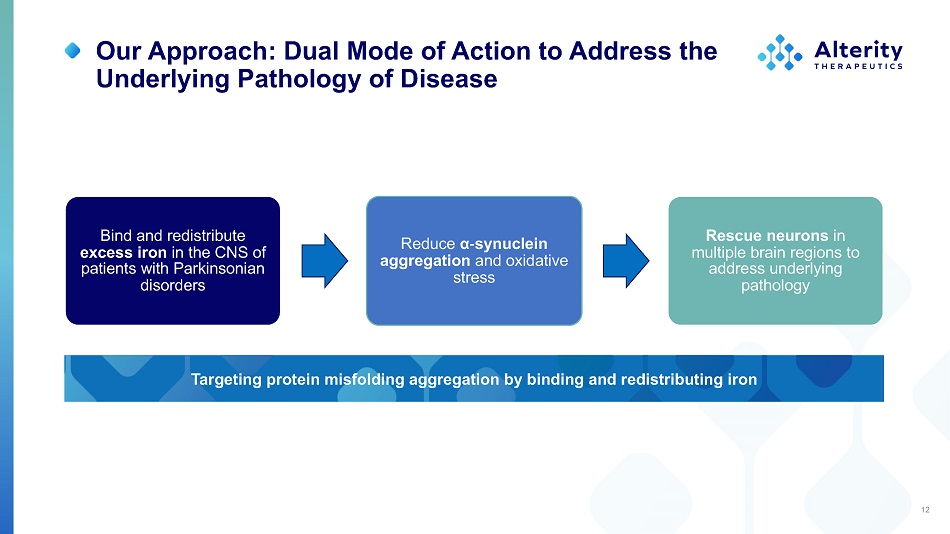
Our Approach: Dual Mode of Action to Address the Underlying Pathology of Disease 12 Bind and redistribute excess iron in the CNS of patients with Parkinsonian disorders Reduce α - synuclein aggregation and oxidative stress Rescue neurons in multiple brain regions to address underlying pathology Targeting protein misfolding aggregation by binding and redistributing iron
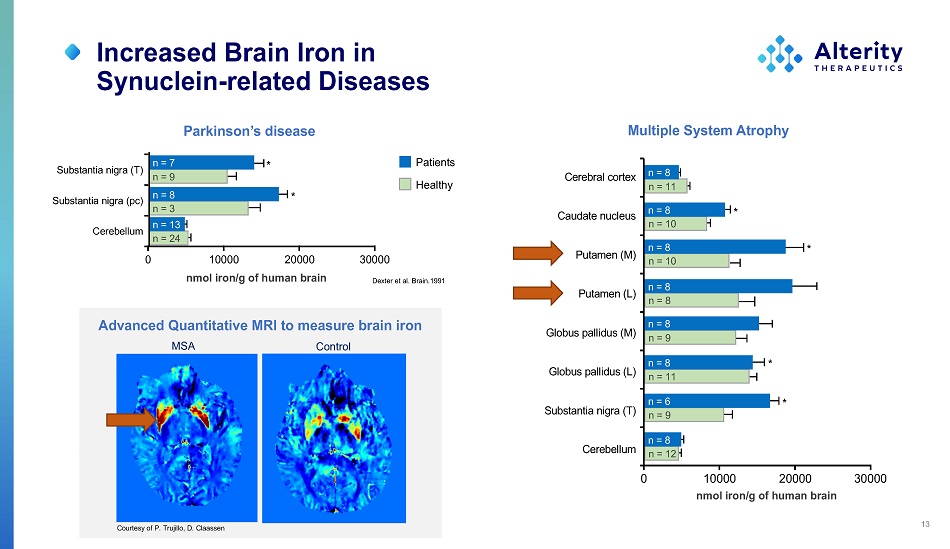
Increased Brain Iron in Synuclein - related Diseases 13 Dexter et al. Brain.1991 Parkinson’s disease Multiple System Atrophy Courtesy of P. Trujillo, D. Claassen n = 24 n = 13 n = 9 n = 7 * n = 3 n = 8 * 10000 20000 nmol iron/g of human brain 0 30000 C e r eb r a l c o rt e x C auda t e nu c l eu s P u t a m e n ( M ) P u t a m e n ( L ) G l obu s pa lli du s ( M ) G l obu s pa lli du s ( L ) S ubs t an t i a n i g r a ( T ) C e r ebe ll u m n = 11 n = 8 n = 8 n = 8 n = 9 n = 8 n = 12 n = 8 n = 11 n = 8 * n = 9 n = 6 * 0 30000 n = 10 n = 8 * n = 10 n = 8 * 10000 20000 nmol iron/g of human brain Patients Healthy Substantia nigra (T) Substantia nigra (pc) C e r ebe ll u m Advanced Quantitative MRI to measure brain iron MSA Control
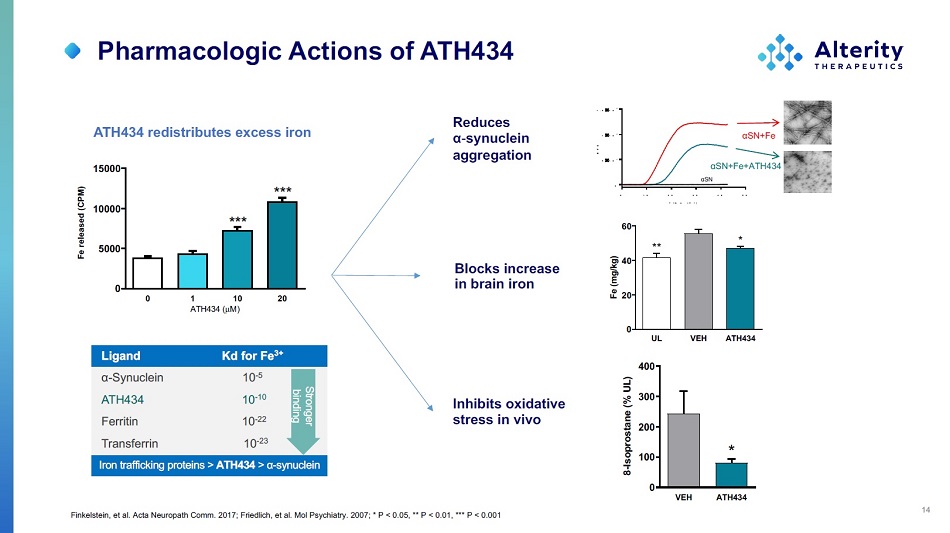
Pharmacologic Actions of ATH434 14 Reduces α - synuclein a gg r e g ati o n α S N +Fe αSN+Fe+ATH434 αSN 1 0 2 0 3 0 4 0 5 0 0 0 5 1 0 4 1 1 0 5 1 . 5 1 0 5 T i m e ( H r ) R F U Finkelstein, et al. Acta Neuropath Comm. 2017; Friedlich, et al. Mol Psychiatry. 2007; * P < 0.05, ** P < 0.01, *** P < 0.001 Blocks increase in brain iron Inhibits oxidative stress in vivo 0 1 1 0 A T H 4 3 4 ( M ) 2 0 0 50 0 0 100 0 0 150 0 0 Fe released (CPM) ** * ** * ATH434 redistributes excess iron Ligand Kd for Fe 3+ α - S y nu c lei n ATH434 Ferritin T r an sf e rr i n 10 - 5 10 - 10 10 - 22 10 - 23 Ir o n tr a ff i ck i n g p r o t e i n s > A T H 43 4 > α - synuc l e i n U L V E H A TH434 0 20 40 60 F e ( m g /k g ) * * * S tr onge r binding V E H ATH4 3 4 0 1 0 0 2 0 0 3 0 0 4 0 0 8 - Isoprostane (% UL) *
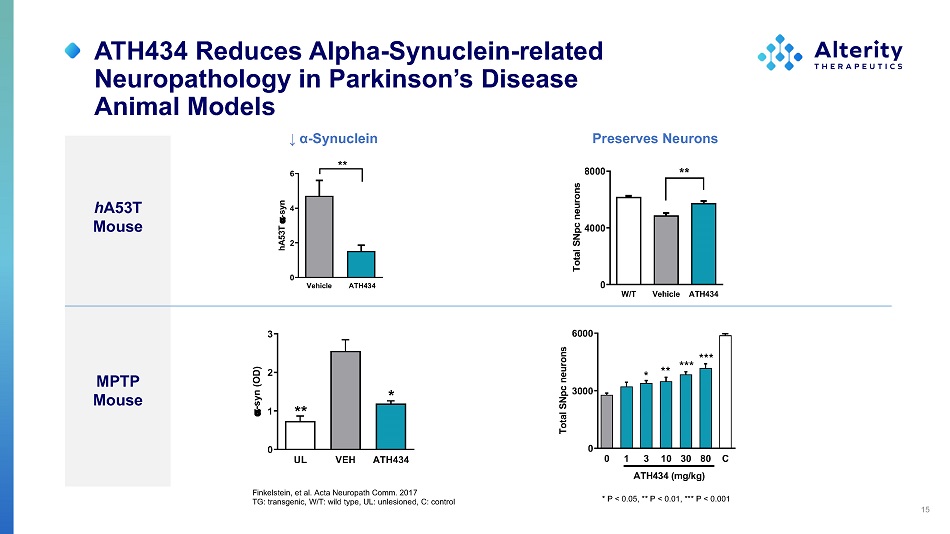
MPTP M ous e hA53T - syn V e h icl e ATH 4 3 4 0 2 4 6 h A53T M ous e Finkelstein, et al. Acta Neuropath Comm. 2017 TG: transgenic, W/T: wild type, UL: unlesioned, C: control ↓ α - Synuclein Preserves Neurons ** * P < 0.05, ** P < 0.01, *** P < 0.001 Total SNpc neurons W / T Vehicle ATH434 0 40 0 0 80 0 0 * * U L VEH ATH434 0 1 2 3 ** * - syn (OD) 0 1 3 10 30 80 C 0 30 0 0 60 0 0 Total SNpc neurons ATH434 (mg/kg) *** *** * * * ATH434 Reduces Alpha - Synuclein - related Neuropathology in Parkinson’s Disease Animal Models 15
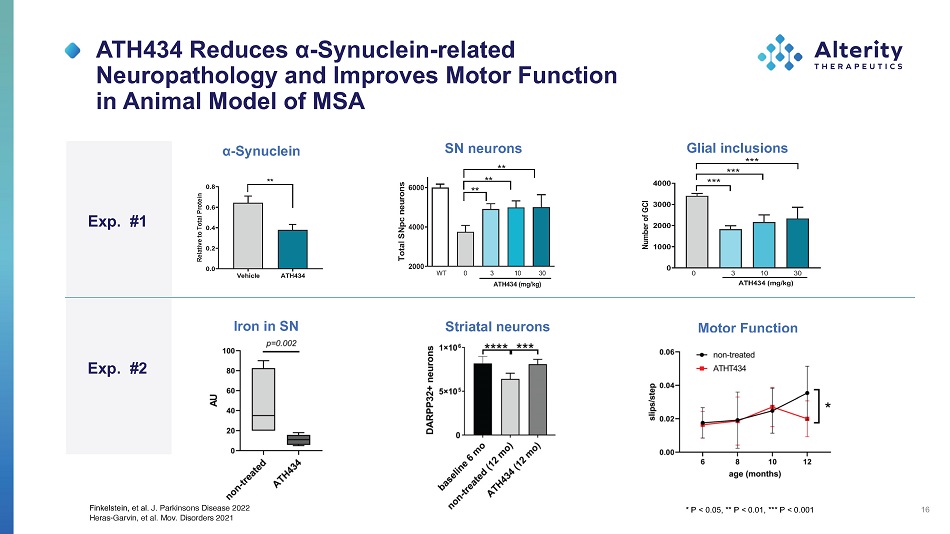
ATH434 Reduces α - Synuclein - related Neuropathology and Improves Motor Function in Animal Model of MSA 16 * P < 0.05, ** P < 0.01, *** P < 0.001 Vehicle A TH434 0 . 0 0 . 2 0 . 4 0 . 6 0 . 8 Re l a t i v e t o To t a l P r o t e i n * * α - S y nu clei n Finkelstein, et al. J. Parkinsons Disease 2022 Heras - Garvin, et al. Mov. Disorders 2021 SN neurons 20 0 0 40 0 0 60 0 0 Total SNpc neurons * * * * ** 0 3 1 0 3 0 W T A T H 43 4 ( m g /k g ) 0 10 0 0 20 0 0 30 0 0 40 0 0 Numb e r o f G C I ** * Glial inclusions *** *** 0 3 1 0 3 0 A TH 43 4 ( m g /k g ) Motor Function Exp. #1 Striatal neurons Iron in SN Exp. #2
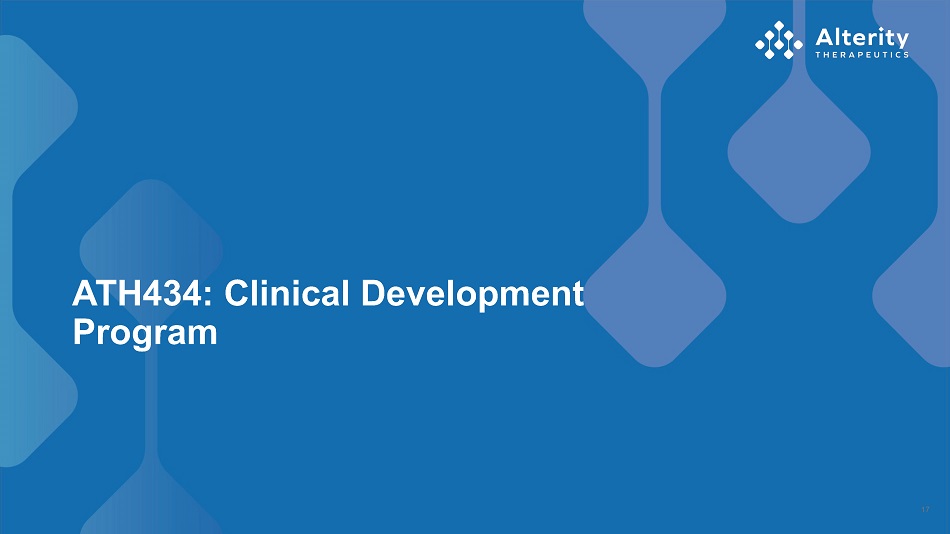
ATH434: Clinical Development Program 17
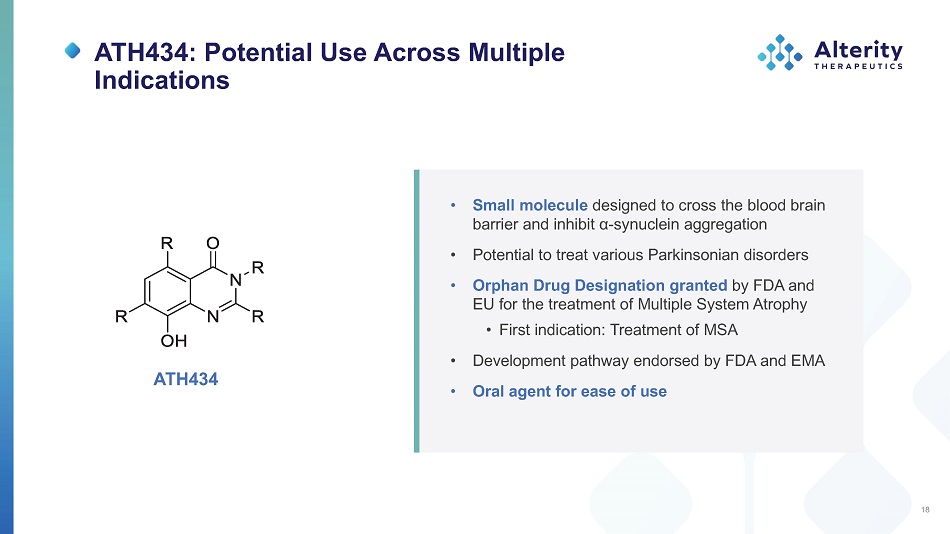
ATH434: Potential Use Across Multiple Indications • Small molecule designed to cross the blood brain barrier and inhibit α - synuclein aggregation • Potential to treat various Parkinsonian disorders • Orphan Drug Designation granted by FDA and EU for the treatment of Multiple System Atrophy • First indication: Treatment of MSA • Development pathway endorsed by FDA and EMA • Oral agent for ease of use ATH434 18
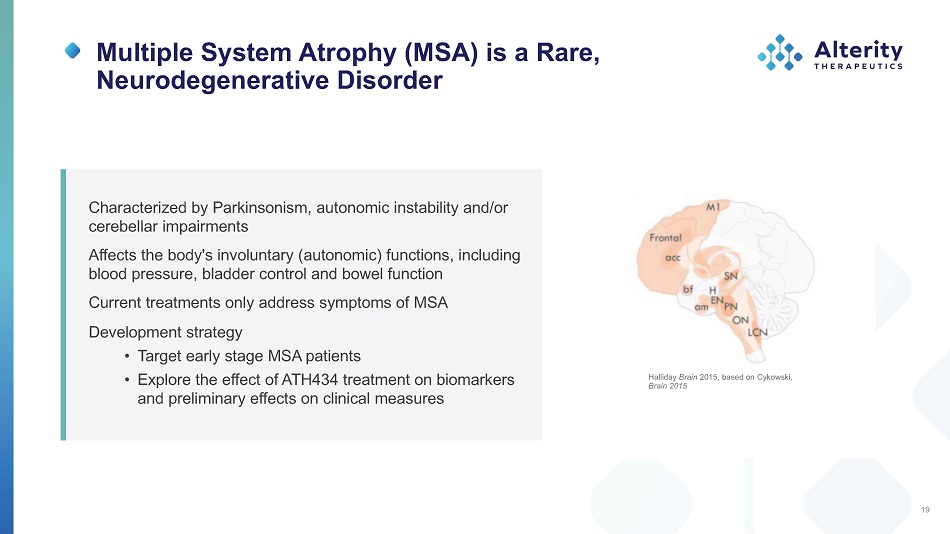
Multiple System Atrophy (MSA) is a Rare, Neurodegenerative Disorder Characterized by Parkinsonism, autonomic instability and/or cerebellar impairments Affects the body's involuntary (autonomic) functions, including blood pressure, bladder control and bowel function Current treatments only address symptoms of MSA Development strategy • Target early stage MSA patients • Explore the effect of ATH434 treatment on biomarkers and preliminary effects on clinical measures Halliday Brain 2015, based on Cykowski, Brain 2015 19
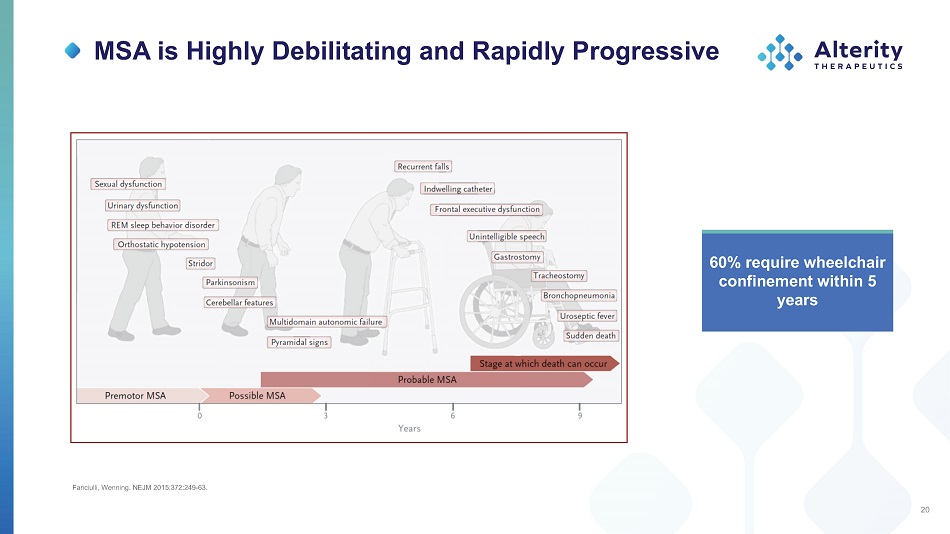
MSA is Highly Debilitating and Rapidly Progressive Fanciulli, Wenning. NEJM 2015;372:249 - 63. 60% require wheelchair confinement within 5 years 20
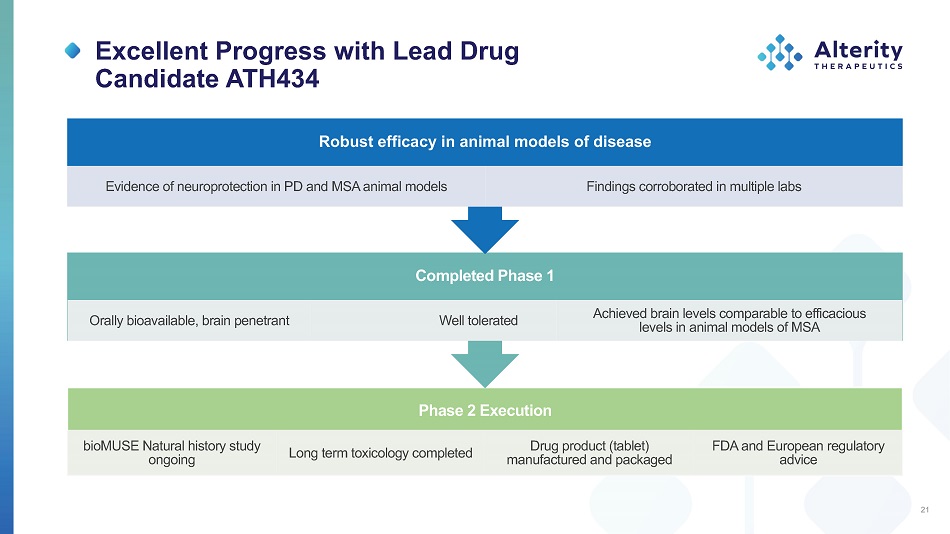
Excellent Progress with Lead Drug Candidate ATH434 Phas e 2 Execution bioMUS E Natura l histor y study ongoing Lon g ter m toxicolog y completed Dru g produc t (tablet) manufacture d an d packaged F D A an d E uropea n regu l atory advice Complete d Phas e 1 Orall y bioavailable , brai n penetrant W e l l to l erate d Achieved brain levels comparable to efficacious level s i n anima l model s o f MSA Robust efficacy in animal models of disease Evidenc e o f neuroprotectio n i n P D an d MS A anima l model s F i nd i ng s corroborate d i n mu l t i p l e l abs 21
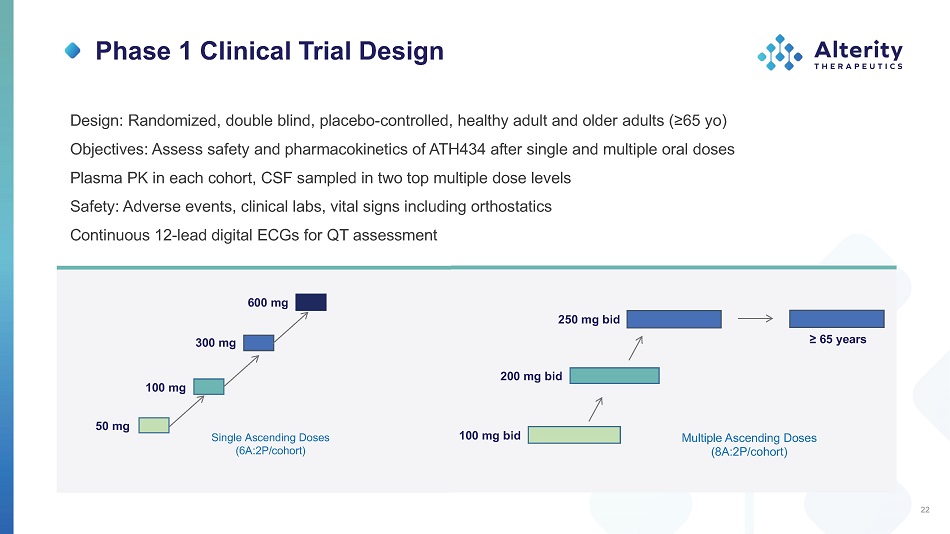
Phase 1 Clinical Trial Design Design: Randomized, double blind, placebo - controlled, healthy adult and older adults (≥65 yo) Objectives: Assess safety and pharmacokinetics of ATH434 after single and multiple oral doses Plasma PK in each cohort, CSF sampled in two top multiple dose levels Safety: Adverse events, clinical labs, vital signs including orthostatics Continuous 12 - lead digital ECGs for QT assessment Single Ascending Doses (6A:2P/cohort) 50 mg 600 mg 300 mg 100 mg M ul t ipl e A sc endin g Do s e s (8A:2P/cohort) 100 mg bid 200 mg bid 250 mg bid ≥ 65 years 22
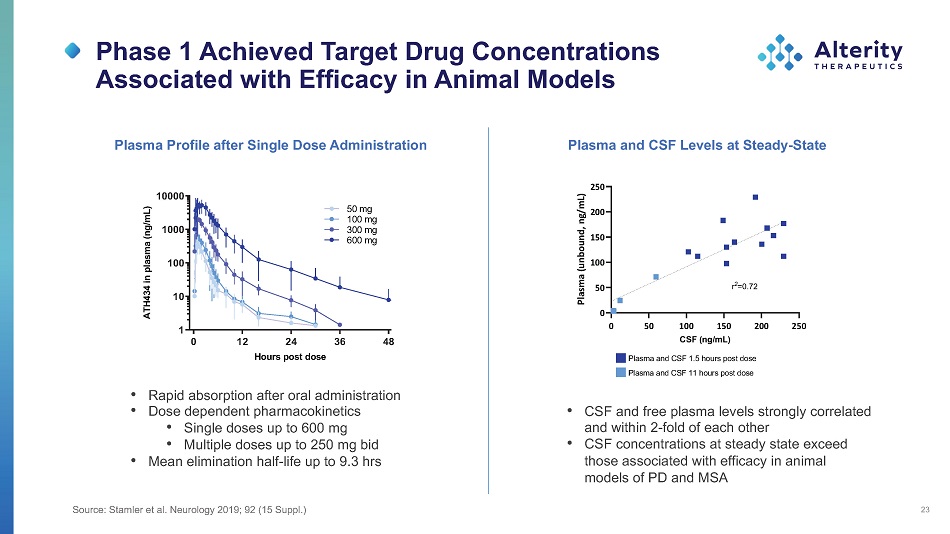
Phase 1 Achieved Target Drug Concentrations Associated with Efficacy in Animal Models 23 Plasma Profile after Single Dose Administration • Rapid absorption after oral administration • Dose dependent pharmacokinetics • Single doses up to 600 mg • Multiple doses up to 250 mg bid • Mean elimination half - life up to 9.3 hrs 0 1 2 3 6 4 8 1 1 0 100 1000 10000 24 Hours post dose ATH434 in plasma (ng/mL) 50 mg 10 0 m g 30 0 m g 60 0 m g 0 5 0 2 5 0 1 0 0 1 5 0 2 0 0 CSF (ng/mL) 0 5 0 1 0 0 1 5 0 2 0 0 2 5 0 Plasma (unbound, ng/mL) r 2 =0.72 Plasma and CSF 1.5 hours post dose Plasma and CSF 11 hours post dose Plasma and CSF Levels at Steady - State • CSF and free plasma levels strongly correlated and within 2 - fold of each other • CSF concentrations at steady state exceed those associated with efficacy in animal models of PD and MSA Source: Stamler et al. Neurology 2019; 92 (15 Suppl.)
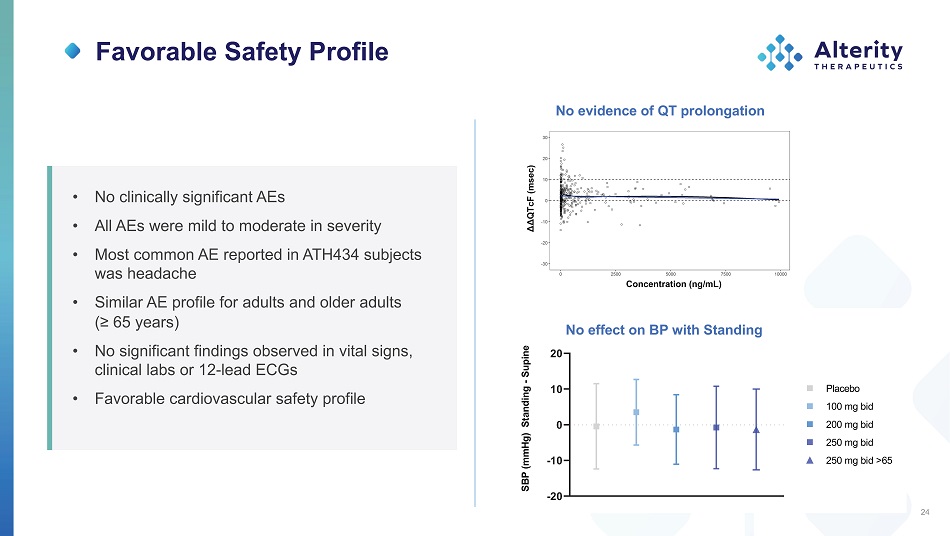
Favorable Safety Profile • No clinically significant AEs • All AEs were mild to moderate in severity • Most common AE reported in ATH434 subjects was headache • Similar AE profile for adults and older adults (≥ 65 years) • No significant findings observed in vital signs, clinical labs or 12 - lead ECGs • Favorable cardiovascular safety profile - 2 0 - 1 0 0 1 0 2 0 SBP (mmHg) Standing - Supine Placebo 10 0 m g b i d 20 0 m g b i d 25 0 m g b i d 250 mg bid >65 ΔΔQTcF (msec) Concentration (ng/mL) No evidence of QT prolongation No effect on BP with Standing 24
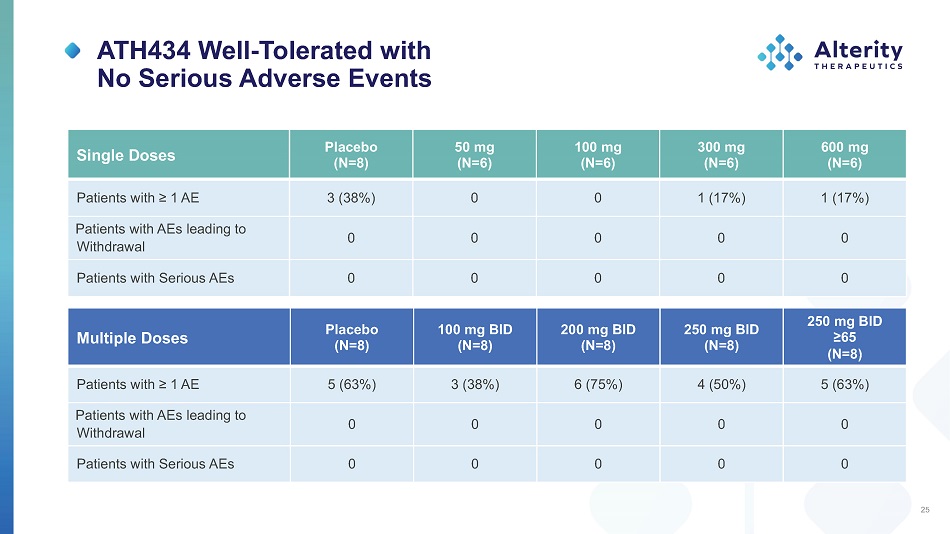
ATH434 Well - Tolerated with No Serious Adverse Events Single Doses P lace b o (N=8) 5 0 mg (N=6) 10 0 mg (N=6) 30 0 mg (N=6) 60 0 mg (N=6) Patients with ≥ 1 AE 3 (38%) 0 0 1 (17%) 1 (17%) P at i ent s wi t h AEs l ead i n g t o Withdrawal 0 0 0 0 0 Patients with Serious AEs 0 0 0 0 0 Multiple Doses P lace b o (N=8) 100 mg BID (N=8) 200 mg BID (N=8) 250 mg BID (N=8) 250 mg BID ≥65 ( N =8) Patients with ≥ 1 AE 5 (63%) 3 (38%) 6 (75%) 4 (50%) 5 (63%) P at i ent s wi t h AEs l ead i n g t o Withdrawal 0 0 0 0 0 Patients with Serious AEs 0 0 0 0 0 25
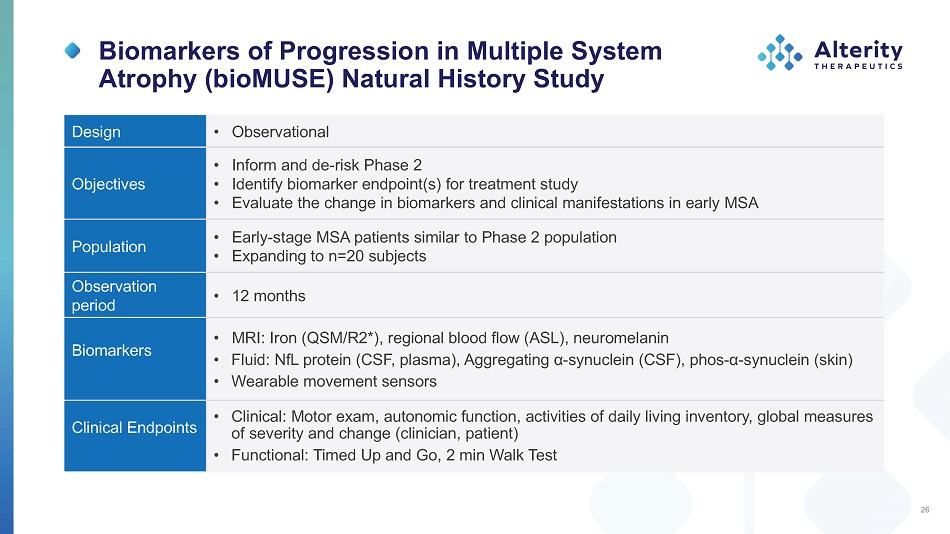
Biomarkers of Progression in Multiple System Atrophy (bioMUSE) Natural History Study Design • Observational Objectives • Inform and de - risk Phase 2 • Identify biomarker endpoint(s) for treatment study • Evaluate the change in biomarkers and clinical manifestations in early MSA Population • Early - stage MSA patients similar to Phase 2 population • Expanding to n=20 subjects O b s e rv a t i o n period • 12 months Biomarkers • MRI: Iron (QSM/R2*), regional blood flow (ASL), neuromelanin • Fluid: NfL protein (CSF, plasma), Aggregating α - synuclein (CSF), phos - α - synuclein (skin) • Wearable movement sensors Clinical Endpoints • Clinical: Motor exam, autonomic function, activities of daily living inventory, global measures of severity and change (clinician, patient) • Functional: Timed Up and Go, 2 min Walk Test 26
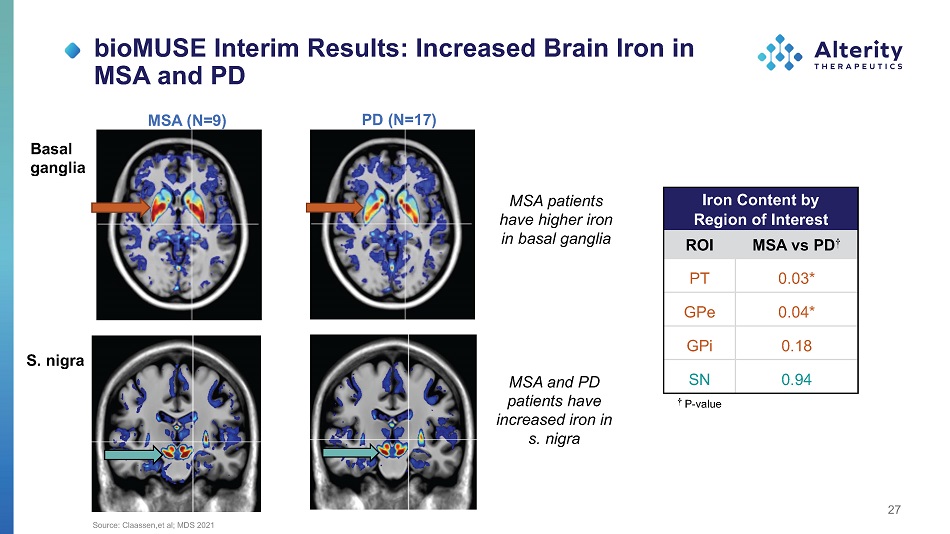
bioMUSE Interim Results: Increased Brain Iron in MSA and PD MSA (N=9) PD (N=17) Basal gang li a MSA patients have higher iron in basal ganglia 27 S. nigra MSA and PD patients have increased iron in s. nigra Iron Content by Region of Interest ROI MSA vs PD † PT 0.03* GPe 0.04* GPi 0.18 SN 0.94 † P - value Source: Claassen,et al; MDS 2021
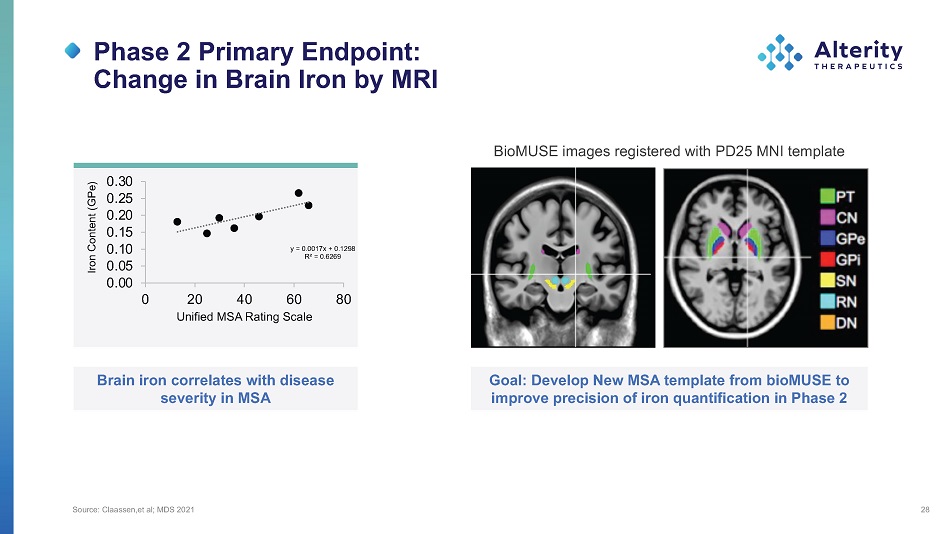
Phase 2 Primary Endpoint: Change in Brain Iron by MRI Source: Claassen,et al; MDS 2021 28 BioMUSE images registered with PD25 MNI template Goal: Develop New MSA template from bioMUSE to improve precision of iron quantification in Phase 2 Brain iron correlates with disease severity in MSA y = 0.0017x + 0.1298 R² = 0.6269 0 . 3 0 0 . 2 5 0 . 2 0 0 . 1 5 0 . 1 0 0 . 0 5 0 . 0 0 Iron Content (GPe) 0 2 0 4 0 6 0 80 Unified MSA Rating Scale
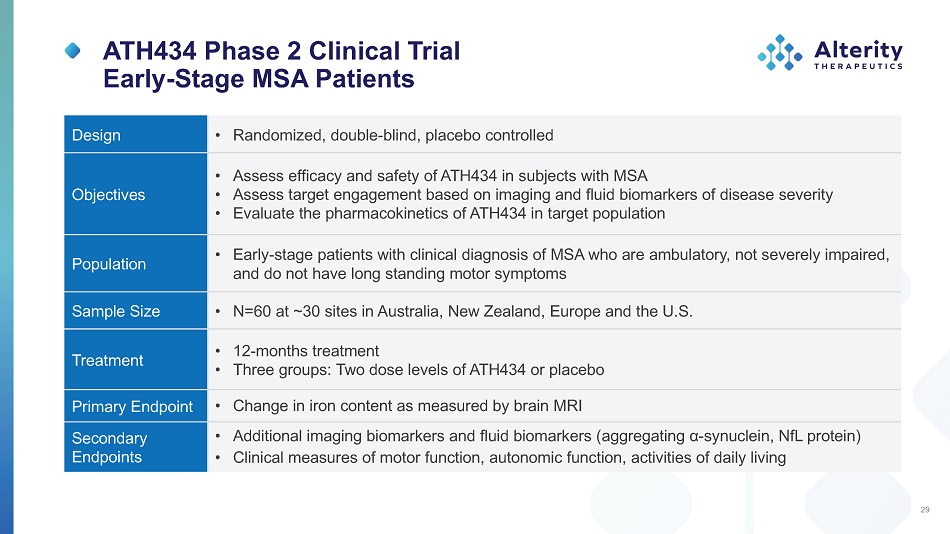
ATH434 Phase 2 Clinical Trial Early - Stage MSA Patients Design • Randomized, double - blind, placebo controlled Objectives • Assess efficacy and safety of ATH434 in subjects with MSA • Assess target engagement based on imaging and fluid biomarkers of disease severity • Evaluate the pharmacokinetics of ATH434 in target population Population • Early - stage patients with clinical diagnosis of MSA who are ambulatory, not severely impaired, and do not have long standing motor symptoms Sample Size • N=60 at ~30 sites in Australia, New Zealand, Europe and the U.S. Treatment • 12 - months treatment • Three groups: Two dose levels of ATH434 or placebo Primary Endpoint • Change in iron content as measured by brain MRI Se c onda ry Endpoints • Additional imaging biomarkers and fluid biomarkers (aggregating α - synuclein, NfL protein) • Clinical measures of motor function, autonomic function, activities of daily living 29
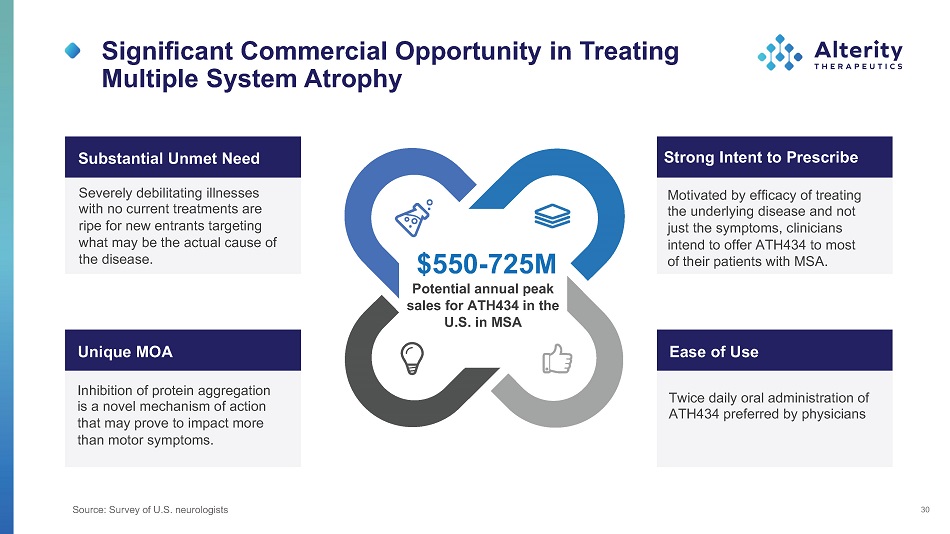
Significant Commercial Opportunity in Treating Multiple System Atrophy 30 Severely debilitating illnesses with no current treatments are ripe for new entrants targeting what may be the actual cause of the disease. Substantial Unmet Need Motivated by efficacy of treating the underlying disease and not just the symptoms, clinicians intend to offer ATH434 to most of their patients with MSA. Strong Intent to Prescribe Twice daily oral administration of ATH434 preferred by physicians Ease of Use Inhibition of protein aggregation is a novel mechanism of action that may prove to impact more than motor symptoms. Unique MOA $550 - 725M Potential annual peak sales for ATH434 in the U.S. in MSA Source: Survey of U.S. neurologists
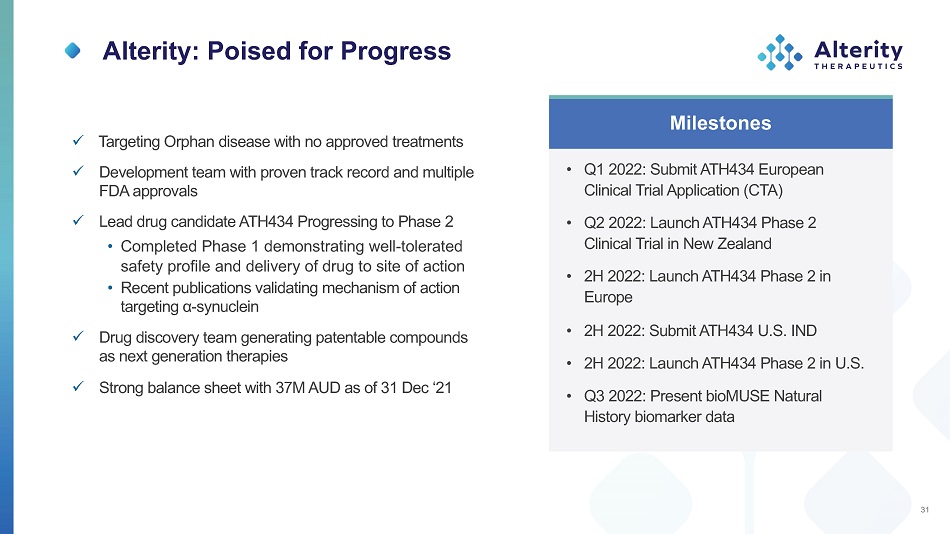
Alterity: Poised for Progress 31 x Targeting Orphan disease with no approved treatments x Development team with proven track record and multiple FDA approvals x Lea d d r u g cand i da t e A TH43 4 P r og r ess i n g t o P has e 2 • Completed Phase 1 demonstrating well - tolerated safety profile and delivery of drug to site of action • Recent publications validating mechanism of action t a r ge t in g α - sy nu c le i n x D r u g d i scove r y t ea m gene r a t i n g pa t en t ab l e co m pound s a s nex t gene r a t i o n t he r ap i es x S t r on g balan c e s hee t wi t h 37 M AU D a s o f 3 1 D e c ‘ 2 1 Milestones • Q 1 2022 : Sub m i t A TH43 4 Eu r opea n Cli n i ca l T r i a l A pp li ca t i o n ( C T A) • Q 2 2022 : Laun c h A TH43 4 Pha s e 2 Cli n i ca l T r i a l i n N e w Zea l an d • 2 H 2022 : Launc h A TH43 4 P has e 2 i n Europe • 2 H 2022 : S ub m i t A TH43 4 U . S . I N D • 2 H 2022 : Launc h A TH43 4 P has e 2 i n U . S . • Q3 2022: Present bioMUSE Natural Hi s t o r y b i o m a r ke r da t a
































